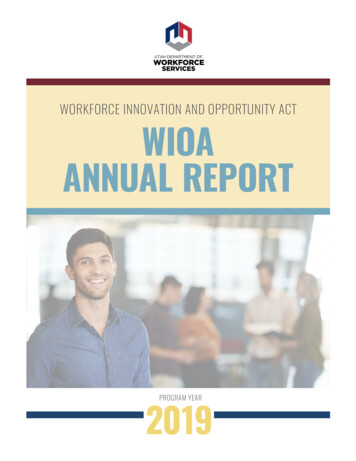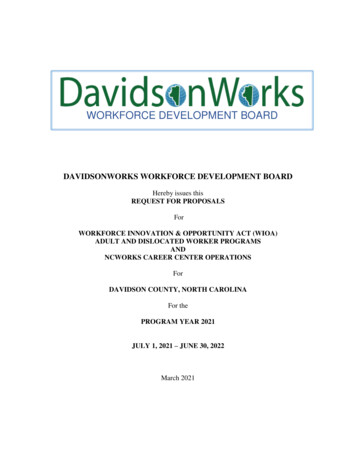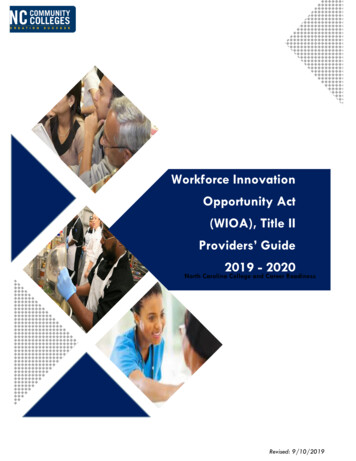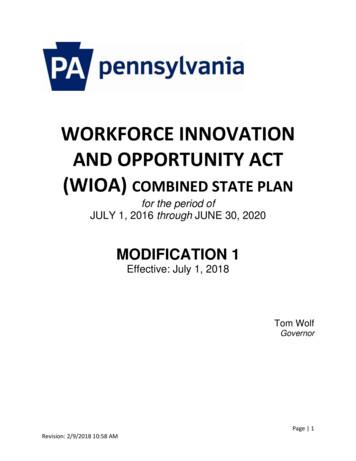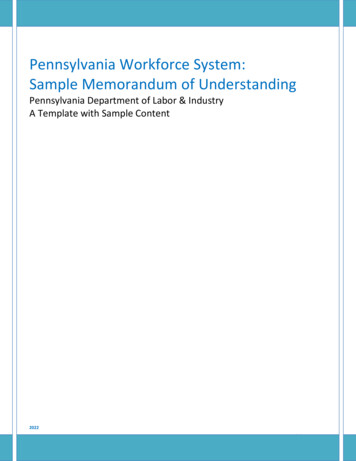
Transcription
Workforce Innovation and Opportunity Act (WIOA)Annual Statewide Performance Report NarrativeProgram Year 2018Reporting Period July 1, 2018 to June 30, 2019December 2, 2019Tom WolfGovernor1Commonwealth of PennsylvaniaPY 2018 WIOA Annual Statewide Performance Report Narrative
Contact InformationJames MartiniExecutive DirectorPA Workforce Development Board651 Boas Street, Room 514Harrisburg, PA 17121jamartini@pa.govEileen CiprianiDeputy Secretary for Workforce DevelopmentPA Department of Labor & Industry651 Boas Street, Room 1700Harrisburg, PA 17121ecipriani@pa.govDan KubaDirector, Bureau of Workforce Development AdministrationPA Department of Labor & Industry651 Boas Street, 12th FloorHarrisburg, PA 17121dkuba@pa.govRuben PachayDirector, Bureau of Workforce Partnership and OperationsPA Department of Labor & Industry651 Boas Street, 12th FloorHarrisburg, PA 17121rpachay@pa.govEric RamsayDirector, Apprenticeship and Training OfficePA Department of Labor & Industry651 Boas Street, 12th FloorHarrisburg, PA 17121eramsay@pa.govEd LeggeDirector, Center for Workforce Information and AnalysisPA Department of Labor & Industry651 Boas Street, 2nd FloorHarrisburg, PA 17121elegge@pa.gov2Commonwealth of PennsylvaniaPY 2018 WIOA Annual Statewide Performance Report Narrative
Table of ContentsWaivers . 4Effectiveness in Serving Employers Pilot . 4Evaluations . 5LEAN Evaluation of One-Stop Operating Budget Processing. 5Mobile Concepts . 5CWDS Technology and Visioning . 5Pre-Apprenticeship Research and Survey. 6Career Pathways . 6Reentry. 6Approach to Customer Satisfaction . 7Customer Satisfaction Surveys . 7Staff Satisfaction Surveys . 7Combined State Plan Progress . 8Sector Strategies and Career Pathways . 9Next Generation Industry Partnerships . 9Work-based Learning . 10Career Pathways Research and Survey. 10PA BizWorks . 10Small State Allotment . 11Performance Accountability System. 11Activities Provided with the Governor’s Reserved Funds . 12Rapid Response Activities and Layoff Aversion . 12Wagner-Peyser Activities . 17National Dislocated Worker Grants . 17Technical Assistance Needs . 18Promising Practices, Lessons Learned, and Success Stories . 18Co-enrollment Cohort . 18Serving Employers and Individuals with Disabilities . 19Adult Basic Education . 20Teacher in the Workplace . 20Business Education Partnerships . 20State/Local Internship Program . 21Pennsylvania Outdoor Corps . 21Youth Reentry . 22Workforce System Challenges . 22Partner Involvement in Costs Associated with the One-Stop System. 22Data Sharing Prohibitions . 22Pay-for-Performance . 23Appendix A . 243Commonwealth of PennsylvaniaPY 2018 WIOA Annual Statewide Performance Report Narrative
WaiversIdentify each waiver that the state has had in place for at least one program year and provideinformation regarding the state’s progress toward achieving the goals and performance outcomes inETA’s letter of approval for the waiver (sec 189(i)(3)(C)(ii)) and outlined in the state’s waiver request(when applicable). Discuss how activities carried out under each approved waiver have directly orindirectly affected state and local area performance outcomes. To the extent possible, providequantitative information.Every WIOA waiver submitted by the Commonwealth of Pennsylvania supports the state’s strategicworkforce development priorities and the efficient and effective delivery of workforce developmentservices across the system. Pennsylvania has two active WIOA waivers approved by the U.S.Department of Labor’s Employment & Training Administration, or USDOL-ETA, during PY 2018:1. Waiver to allow local areas to provide in-school youth (ages 16-21) with Individual TrainingAccounts WIOA and Regulatory Citation(s): 20 CFR 681.550 USDOL approved this waiver on September 28, 20182. Waiver to allow flexibility in the use of WIOA funds reserved by the Governor to provide statewiderapid response activities and other employment and training activities when a qualifying disasterevent occurs WIOA and Regulatory Citation(s): WIOA 134(a)(2)(A), 134(a)(2)(B) and 134(a)(3) USDOL approved this waiver on December 3, 2018Both waivers were approved by USDOL after the start of the 2018 program year. Since a WIOA waivermust be available for use during a full program year so that an effective evaluation of the waiver canbe completed, the Commonwealth will evaluate WIOA waivers available for use during the entirety ofprogram year 2019 and report the findings within the PY 2019 WIOA Annual Performance ReportNarrative.Effectiveness in Serving Employers PilotIdentify the two approaches the state has chosen for the Effectiveness in Serving Employers performanceindicator pilot. If the state is piloting a state-established measure of Effectiveness in Serving Employers,or has any other metrics to assess employer engagement, describe the measure or metric as well.Pennsylvania has two selected measures for the Effectiveness in Serving Employers performanceindicator pilot: Employer Penetration Rate and Repeat Business Customers. In addition to these federalmeasures, Pennsylvania has also selected to pilot three state-established measures: Employer Penetration Rate: Will be measured each quarter, rather than annually, using,the FEIN definition of employer in the denominator, rather than the QCEW definition ofestablishments.Repeat Business Customers: Will be measured each quarter, rather than annually. This iscalculated by dividing the number of establishments in the Commonwealth WorkforceDevelopment System, or CWDS, Pennsylvania’s statewide system of record, that received aservice within both the current quarter and the previous quarter, by the number ofestablishments in CWDS that received a service in the previous quarter.4Commonwealth of PennsylvaniaPY 2018 WIOA Annual Statewide Performance Report Narrative
Active Job Orders with Referrals: Will be measured each quarter, rather than annually. This willbe calculated by dividing the total number of job orders receiving a referral within a givenquarter, by the total number of active job orders within a given quarter.EvaluationsInclude brief descriptions of: (a) current or planned evaluation and related research projects, includingmethodologies used; (b) efforts to coordinate the development of such projects with WIOA coreprograms, other state agencies, and local boards; (c) a list of completed evaluation and related reportsand links to where they were made accessible to the public electronically; (d) State efforts to providedata, survey responses, and timely site visits for Federal evaluations; and (e) any continuousimprovement strategies utilizing results from studies and evidence-based practices evaluated.Pennsylvania engaged in or continued several research projects during PY 2018. Each project isdescribed below, addressing items (a) through (e), when applicable.LEAN Evaluation of One-Stop Operating Budget ProcessingIn alignment with Governor Wolf’s GO-TIME (Governor’s Office of Transformation InnovationManagement and Efficiency) initiative, the Pennsylvania Department of Labor & Industry, or L&I, inpartnership with local workforce development boards, or LWDBs, and representatives from other stateagencies, is working to improve the review process of the one-stop, or PA CareerLink , operatingbudgets. Initially, L&I focused on improving its internal review process by implementing the concepts ofLEAN.Moving forward, L&I will be working with multiple entities, beginning with local workforce servicedelivery system staff, to enhance the overall review process to create a new and enhanced process inthe state’s workforce financial management system. It is anticipated that this enhancement to CWDS2.0 will significantly decrease the time currently involved in the budgeting process, while increasingefficiency at the same time. Staff at every level of Pennsylvania’s workforce system will have a chanceto identify opportunities to improve the process.Mobile ConceptsL&I has contracted with Jobs for the Future, or JFF, to take a deeper look into the Northwest WorkforceDevelopment Area’s mobile method of service delivery. With JFF’s national presence and familiaritywith similar approaches to service delivery, this entity will help provide Pennsylvania’s workforcedevelopment staff and partners with various options for providing the best services to the system’sever-changing customers -- both employers and jobseekers -- as well as the state’s incumbentworkforce. L&I intends to use this evaluation as a foundation for evaluating the Commonwealth’sservice delivery system overall.CWDS Technology and VisioningIn 2018, the Commonwealth engaged in a targeted survey campaign to elicit feedback from users ofthe system of record, CWDS. The results of those surveys indicate two clear areas for improvement:enhanced case management capabilities for staff and a streamlined public-user experience in PACareerLink online.In January 2019, a visioning session, which included Commonwealth field and central office staff,WIOA title I contractor staff, L&I’s Office of Vocational Rehabilitation, or OVR, staff and the PADepartment of Human Services, or DHS, staff, was held to evaluate the surveys and further explore the5Commonwealth of PennsylvaniaPY 2018 WIOA Annual Statewide Performance Report Narrative
issues presented. Again, the themes that emerged are the need for case management upgrades forstaff and a redesigned, more user-friendly public online system.Two focus groups were conducted to validate the subjects identified through both the surveys, andthe visioning lab. The first session included local board leaders and was centered around casemanagement capabilities and executive-level dashboard views. The second session was for publicusers of both PA CareerLink centers and online services. The participants of the focus group wereidentified and recruited by local PA CareerLink center staff. Both sessions provided valuable insightinto the needs of users.The Department of Labor & Industry concurrently conducted a human-centered design evaluation tounderstand, first-hand, the experiences of the PA CareerLink center customer. A third-party vendorwas procured to work with local PA CareerLink staff and customers to understand how theCommonwealth can improve and align the delivery of in-person and online services.Pre-Apprenticeship Research and SurveyThe PY 2017 WIOA Annual Performance Report Narrative highlighted the Pennsylvania WorkforceDevelopment Board’s, or PA WDB’s, partnership with L&I’s Apprenticeship and Training Office, or ATO,in engaging a third-party vendor to survey the status of pre-apprenticeships around the state.Results include a total of 112 respondents, with 63 of those respondents fully completing the survey.The survey completers represent 36 programs who provided programming to nearly 1,440 studentpre-apprentices. Nearly 85 percent of the represented pre-apprentices completed their program, withthe top four programs totaling between 50 - 220 pre-apprentices linked to programs in construction,energy, manufacturing, and metals manufacturing. Other notable results indicate that two-thirds ofthe respondents who provided an age-range of their student participants served 11th and 12th graders,a quarter served younger grades, and a third fell within the WIOA out-of-school youth age range, 16 24 years.Another notable result indicated that 44 of Pennsylvania’s 67 counties are being served by preapprenticeship programs and in many, if not all cases, these programs are not starting fromscratch. Those unserved counties did not have a community college or university branch campus,making tuition costs prohibitively expensive. This presents an opportunity for the targeting of PAsmartfunds to pool, share, and build on existing knowledge and overcome rural post-secondary educationlimitations.Career PathwaysIn 2018, the PA WDB began focusing on career pathways across Pennsylvania. The board is researchingthe various career pathways best practices, statewide. This research will be informed by interviews withPA WDB committee members, national experts, representatives from the PA Governor’s Office, as wellas the 22 LWDBs. These interviews will include a focus on how each local board defines career pathways,career pathways engagement with higher education, how pre-apprenticeship and apprenticeshipprograms are incorporated into career pathways, and more.ReentryWhile there are many great reentry programs operating within Pennsylvania, there is not currently aresource cataloging these programs. The PA WDB’s Reentry Committee has initiated the creation of aninventory of reentry services being conducted across Pennsylvania. The purpose of this inventory is to6Commonwealth of PennsylvaniaPY 2018 WIOA Annual Statewide Performance Report Narrative
provide information and a forum for organizations and practitioners to share best practices, learn fromothers in the field, and seek partnerships. This inventory will not only highlight best practices but willalso identify gaps and duplications of reentry services around the state.In addition to the inventory of reentry services, the Reentry Committee has partnered with the stateAttorney General Office’s Pennsylvania Reentry Council to plan and hold multiple Reentry Roundtablesessions statewide for the main purpose of engaging with employers to share information and resourcesregarding the benefits of hiring reentrants, as well as helping to address any employer questions andconcerns. The first Reentry Roundtable was held in Philadelphia, with the partnership of the PhiladelphiaWorkforce Development Board, in October 2019. Future sessions are being planned for Spring 2020.The feedback garnered during these sessions will also contribute to the future development of a ReentryToolkit with best practices and other resources for employers around hiring returning citizens.Approach to Customer SatisfactionDescribed the state’s approach to customer satisfaction, which may include such information used forone-stop center certification, in accordance with 20 CFR 678.800. This description should include: 1) thestate’s methodologies; 2) the number of individuals/employers who were provided customer satisfactionoutreach, the response rate, and efforts made to improve the response rate; 3) the results and whetherthe results are generalizable to the entire population of customers; and 4) a description of anycontinuous improvement processes for incorporating the customer satisfaction feedback.Customer Satisfaction SurveysThe Commonwealth has created a strategy to address the issues identified through the researchconducted during both 2018 and 2019. There has been engagement in the redesign of PA CareerLink online and close collaboration with the PA Department of Human Services, or DHS, OVR, and the PADepartment of Military and Veterans Affairs, to ensure robust service to shared customers. The PADepartment of Corrections is being consulted to incorporate enhanced reentry services and job searchfunctionality into PA CareerLink online. A cognitive model is being designed for case management thatuses predictive analytics to assist front-line case managers in guiding customers to the services mostlikely to ensure their success in the program. Enhancements to case management dashboards in CWDSand the creation of executive-level dashboards are being prioritized and are expected to be inproduction by November 2020.Staff Service TrainingL&I has provided various trainings for PA CareerLink and LWDB offices to maintain staff readiness inproviding employer and jobseeker services. Since there are new staff in many of the PA CareerLink locations, the department found it necessary to hold a total of 12 “PA CareerLink 101 Foundations ofWorkforce Development” trainings for 193 new staff members. This 2-day class is designed to increaseattendees’ knowledge of workforce development in Pennsylvania (i.e., legislation, programs, and goals)and to sharpen skills for providing high-quality service to customers and colleagues. The trainings wereheld in Harrisburg and each class included staff from various local workforce development areas, orLWDAs.Other trainings planned for the 2020 calendar year include: The Importance of Coaching vs. Case Management: This training will be available for the more than690 case managers throughout the PA CareerLink system and will focus on helping customerswith significant barriers to employment.7Commonwealth of PennsylvaniaPY 2018 WIOA Annual Statewide Performance Report Narrative
Scam Prevention Training: This mandatory training will be provided to all PA CareerLink staff andwill help with identifying fraudulent job postings that target vulnerable customers.These trainings will be provided in webinar/classroom format throughout the 23 LWDAs.Combined State Plan ProgressProgress made in achieving the state’s strategic vision and goals, as described in the state’s Unified orCombined State Plan, for developing its workforce and meeting employer needs in order to supporteconomic growth and economic self-sufficiency.Pennsylvania continues to make progress on goals outlined in the WIOA Combined State Plan. Somehighlights of this progress include: Goal 1.10 relates to adopting a common definition for career readiness across WIOA partnerprograms. To meet this goal, the PA WDB membership voted in May 2019 to approve thestatewide definition of career readiness that was crafted by its Youth Committee, based on theresults of an earlier career readiness survey developed in partnership with L&I’s Center forWorkforce Information and Analysis, or CWIA. Goal 4.3 relates to implementing a program of capacity building, peer learning, and evaluationto support Next Generation Industry Partnerships and apprenticeship programs, and othermulti-employer workforce intermediaries in delivering greater value to: employers, jobseekers,incumbent workers and new hires, etc. To promote this goal, the PA WDB has commissionedsurveys and studies for both industry partnership and apprenticeship program partners andstakeholders; the results of which serve to educate and inform, as well as drive expansion andimprovements. Additionally, the Commonwealth invests in the planning and hosting of annualIndustry Partnership Roundtable events as well as Apprenticeship Summits to further supportthese partnerships and programs. Goal 5.3 relates to embarking on a comprehensive upgrade of CWDS to provide for betterjobseeker and employer experiences and allow staff greater case management andperformance accountability functionality within and across core programs. To meet this goal,the Commonwealth has engaged in a targeted survey campaign, a visioning session, andhuman-centered design evaluations to develop a strategy, in collaboration with the staff ofmultiple state agencies, for its targeted investment in upgrades to the system of record.Additional information regarding this process is detailed within both the Evaluations andCustomer Satisfaction sections of this report. Goals 5.4, 5.5, and 5.7 all have elements regarding strengthening data sharing and moreeffectively using data, particularly related to conducting evaluations of the workforcedevelopment system, making information available to Pennsylvanians to inform their decisionmaking, and developing a WIOA state plan dashboard to monitor implementation andachievement of workforce development goals. To assist with meeting these goals, the PA WDBmembership voted unanimously to approve the recommendation developed by its ContinuousImprovement Committee for Pennsylvania to publish available information online about theperformance of its workforce development system. This information includes, but is notlimited to:8Commonwealth of PennsylvaniaPY 2018 WIOA Annual Statewide Performance Report Narrative
oooState and local WIOA program performance data, required to be reported to thefederal governmentInformation on discretionary grants awarded by PennsylvaniaAny state-developed performance dataDuring the second half of PY 2018, the PA WDB also launched the process of developing the next WIOACombined State Plan, which will take effect at the start of PY 2020. All relevant state agency partner staffhave been engaged in regular meetings and working groups to inform the development of an effective 4year plan with clearly identified measurables and benchmarks. The PA WDB has also gathered input andfeedback on the WIOA Combined State Plan from its relevant committees. Additionally, during thesummer of 2019, the PA WDB held five local stakeholder listening sessions at various locations across thestate to ensure that all workforce development stakeholders have an opportunity to weigh in on theCommonwealth’s vision and goals for the workforce development system.Sector Strategies and Career PathwaysProgress made in implementing sector strategies and career pathways. The discussion may include:business engagement strategies, work-based learning (including apprenticeship), work experiences foryouth and adults, transitional jobs, and incumbent worker training strategies and policies in the state.Pennsylvania has several initiatives related to both sector strategies and career pathways.Highlights of the Commonwealth’s initiatives are described below:Next Generation Industry PartnershipsPennsylvania has utilized industry partnerships as a sector strategy for over 20 years. In PY 2018, theCommonwealth awarded funding to 28 Next Generation Industry Partnership projects in eight industrysectors. These awards were funded through state dollars and highlight the commitment to continuebuilding sector strategies and industry partnerships.The PA Workforce Development Board, L&I, the PA Department of Community and EconomicDevelopment, or DCED, the PA Department of Education, or PDE, and the Team Pennsylvania Foundationhave all come together to support industry partnerships around the state. This interagency teamdeveloped Next Generation Industry Partnership Statewide Metrics, which are being used to createmeasurable outcomes and ensure quality programs and strategies across the state. These metrics will helpinform future industry partnerships and sector strategies.In addition to these metrics, the Commonwealth conducted a survey of Next Generation IndustryPartnership Conveners and Business Champions. These surveys solicited feedback directly from thebusinesses leading industry partnerships, helping to increase business engagement and improve theprogram. Survey highlights include:The most common outcomes of participating in the partnership for business member partners are: New recruitment practices New or improved internal trainings Support in finding employees with the skills and experiences needed Implementation of new or enhanced processes New Jobs Created Positions filled with qualified candidates9Commonwealth of PennsylvaniaPY 2018 WIOA Annual Statewide Performance Report Narrative
Additionally, as a result of participation in the partnership business members report: More detailed hiring processes, including assessments and testing The ability to provide trainings internally More funds to support quality training and support more incumbent workers New ideas for attracting and enhancing diversityThe most common priorities of the partnerships that responded are: Recruitment/retention Business to business networking Training development and facilitation Talent pipeline development Marketing/outreachThe results of the surveys illustrate how industry partnerships have been successful across Pennsylvania,as well as identifying the opportunities for improvement. These results are being used to shape sectorstrategies and policy going forward.Work-Based LearningAcknowledging the importance of pre-apprenticeships in Governor Wolf’s workforce developmentstrategy, the PA WDB contracted with a third-party vendor to publish its survey findings in an Inventoryof Pre-Apprenticeship Programs Across Pennsylvania (January 7, 2019), which offers forward lookingoptions for strengthening Pennsylvania’s pre-apprenticeship and apprenticeship programs. These optionsinclude outcome measurements, database development and tracking tools, incorporation into overallsector strategy and performance, inclusionary grant solicitations leveraging 2.5 million of grantopportunities to meet grantee-identified funding shortfalls for sustained pre-apprenticeship programmanagement and leveraging educational funding streams. One of the more notable survey findings is therecognition of a capacity building need -- a facet that is both a current limitation and an opportunity.Career Pathways Research and SurveyIn 2019, Pennsylvania is conducting research and a statewide inventory on the status of career pathwaywork. Additional information on this research can be found in the Career Pathways portion of theEvaluations section, earlier in this report.PA BizWorksThe PA Department of Labor & Industry continued work on the PA BizWorks employer guide during the2019 calendar year. The focus group had representatives from L&I, DCED, PDE, and DHS. A rough draft ofthe employer guide was completed and is being routed through the various departments for commentsand requested changes. The content of the guide includes employer services provided by various stateagencies. Its purpose is to provide the employer community with coordinated workforce development,economic development, and other business services provided by the state.Future phases will include training for state agency staff at the various departments around how agenciesand programs can coordinate to efficiently and effectively deliver business services to the employercommunity. This cross-training will be an important aspect of PA BizWorks, as it will allow for staff to haveknowledge of various employer services and fit the mold of a “one-stop shop” for employers.10Commonwealth of PennsylvaniaPY 2018 WIOA Annual Statewide Performance Report Narrative
Small State AllotmentIf the sta
Harrisburg, PA 17121 jamartini@pa.gov Eileen Cipriani Deputy Secretary for Workforce Development PA Department of Labor & Industry 651 Boas Street, Room 1700 Harrisburg, PA 17121 ecipriani@pa.gov Dan Kuba Director, Bureau of Workforce Development Administration PA Department of Labor & Industry 651 Boas Street, 12th Floor Harrisburg, PA 17121

